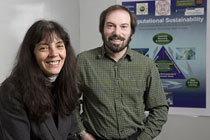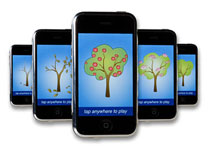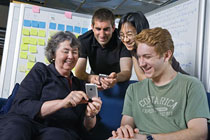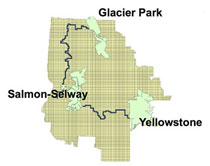RESARCH SPOTLIGHT
New institute will apply computer power to sustainability issues
Could graph theory help a grizzly bear find a mate? Could a computer model help stabilize the tuna population? Can we compute how to transition to ethanol fuel without messing up food production?

Carla Gomes, Cornell associate professor of computing and information science, is director of the new Institute for Computational Sustainability; David Shmoys, right, is associate director. See larger image
On the other hand, could grizzly bears and tuna teach computer scientists something new?
Those are some of the questions to be taken up by the new Institute for Computational Sustainability, launched with a $10 million grant from the National Science Foundation (NSF). Based at Cornell with Carla Gomes, Cornell associate professor of computing and information science, as director (pictured above with associate director David Shmoys), the institute will involve 14 Cornell faculty members along with scientists at Oregon State University, Howard University, Bowdoin College, the Department of Energy's Pacific Northwest National Laboratory and the Conservation Fund. The research brings together computer scientists, applied mathematicians, economists, biologists and environmental scientists.
"Given the well-recognized need for better management and utilization of Earth's rapidly depleting resources, it is imperative and urgent that computer scientists turn their attention to computational problems that arise in this context," Gomes wrote in her proposal to NSF. "Our vision is that computing and information science can -- and should -- play a key role in increasing the efficiency and effectiveness of the way we manage and allocate our natural resources."
Many of today's problems in ecology and conservation involve juggling large numbers of variables, often to find the optimal balance between cost and environmental impact. Some are so complex, the researchers say, that they will require new advances in computer science. Gomes and her team hope to create a new field of computational sustainability, analogous to computational biology, that will stimulate new developments in the computer science areas of constraint optimization (finding the best balance of many variables where there are constraints on some of them), dynamical systems (systems where some variables keep changing) and machine learning.
The institute launches with several interdisciplinary research projects under way, including:
- Wildlife Corridors for Grizzly Bears -- Grizzlies now live mainly in three areas: the Yellowstone, Salmon-Selway and Northern Continental Divide ecosystems, spanning 64 counties in Idaho, Wyoming and Montana. To ensure the viability of the species, conservationists want to acquire land to create corridors connecting these three areas. Optimizing the design of the corridors has already found solutions with dramatically reduced cost compared to previous estimates.
- Biofuels -- This project will include developing models for the transition to an ethanol economy, taking into account the needs of households, landowners, ethanol producers, regular gasoline refiners, food producers, the fraction of land allocated for each of the possible uses, crops rotations and tillage options.
- Bird Conservation -- To preserve bird habitats and design bird corridors, a good understanding of hemispheric-scale bird migrations is required, a daunting task involving literally billions of birds. Studies will use detailed data on bird populations collected through the Citizen Science program of Cornell's Laboratory of Ornithology.
- Rotational Management of Fishing Grounds -- To conserve and buffer valuable fish stocks and marine biodiversity, this project involves developing a computer model to decide the optimal number of ""no-fish zones," their location, size and the number of years they should be open or closed to fishing.
- Pastoral Systems in East Africa -- How does the interaction between precipitation and forage resources, the location of water wells, the dynamics of the groundwater stock and the possibility of fencing and rotating livestock to different pastures influence poverty, food security and environmental stress in Africa?
The institute will collaborate extensively with the Center for a Sustainable Future at Cornell and a number of other sustainability programs on campus.
Researchers affiliated with the institute hope to extend beyond their initial members to other researchers concerned with sustainability issues, in part by making funding available for graduate and undergraduate students.
The project is one of four "Expeditions in Computing" funded by the NSF Directorate for Computer and Information Science and Engineering to pursue "far-reaching research agendas that promise significant advances in the computing frontier and great benefit to society."
Through a cell phone interface, game aims to influence teens to make healthier food choices
Could computer games actually help kids get healthy?
Researchers in Cornell's Food and Brand Lab and Department of Communication think so.
They have designed a game called Mindless Eating Challenge that teens can play on their mobile phones. It links the health and happiness of a virtual pet -- a worm, a dinosaur or a tree, for example -- with real-life choices about eating.

In Mindless Eating Challenge a virtual pet, in this case a tree, withers or flourishes based on the food choices of its teenage owner. See larger image
"It's taking the flipside of the technology," says Geri Gay, the Kenneth J. Bissett '89 Senior Professor of Communication and principal investigator. "The Nintendo Wii has shown us that computers can help people exercise. This game focuses on being conscious about eating."
Here's how it works: Mindless Eating Challenge will send customized tips developed by the Food and Brand Lab to teens' phones several times a day. The choices players then make in their own eating, such as to snack on fruit instead of chips, will affect the health of a virtual pet living on their phone's home screen.
If the teen makes a healthy choice (and proves it by sending a photo to researchers or a peer group), their virtual pet will grow bigger, stronger and happier. Consistent healthy choices will unlock special accessories for their pet, games and fun features. Poor choices will make the pet lethargic, sickly and sad. In some versions, players will be able to see the health of their friends' virtual pets too.
"People have an underlying motivation to become healthy, but on its own it's not enough," says J.P. Pollak, a Ph.D. candidate in information science and a researcher on the project. "The game gives an extra kick."
"It's about negative and positive feedback and how it motivates choices," Gay says.
The work is supported by a grant from the Robert Wood Johnson Foundation, which has committed more than $8 million to its national program for Health Games Research.

From left, Professor Geri Gay, doctoral candidate J.P. Pollak, and students Sara Lin and Ben Davis look at the game Mindless Eating Challenge on two iPhone screens. See larger image
Gay says she and her group are taking on "an amazing epidemic."
More than 17 percent of adolescents in America are overweight, up from 5 percent in the late 1970s, according to the National Health and Nutrition Examination Survey. Health risks to overweight children include type 2 diabetes and such precursors of cardiovascular disease as high cholesterol and high blood pressure. Other risks include social stigma and low self-esteem.
What's more, four out of five children who are overweight in their early teens will be clinically obese by age 25, according to estimates by the National Centers for Disease Control and Prevention.
Electronic games for mobile devices are a new frontier in health research, but Gay and her team are building on extensive knowledge they have collected by experimenting with mobile devices in other contexts, including museums. They believe cell phones make it possible to deliver a persuasive message at the most opportune time -- and get better results.
This may be especially true for teens, whose always-connected relationship with mobile phones is well documented, adds Pollak.
The research group is collecting preliminary data now with plans for a full study in the spring and summer that will involve up to 150 children ages 10--14 in upstate New York. If the results are encouraging, Pollak says, the mobile gaming concept could be adapted to health issues for adults, including smoking cessation and alcoholism.
He acknowledges that mindless eating -- like scarfing down buttery popcorn throughout a long movie -- is only one factor contributing to childhood obesity, but he says calling attention to it can cut down on calories kids weren't really hungry for in the first place.
"It won't feel like dieting," he says. "There are literally hundreds of calories a week you just didn't need to eat."

